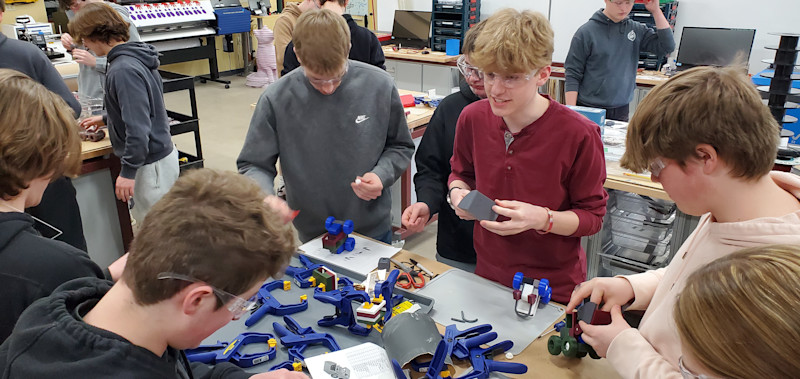Young people in the Dairy State are getting hands-on experience with advanced manufacturing technology thanks to the Fab Lab Grant Program, funded through the Wisconsin Economic Development Corporation (WEDC), a public-private agency that supports industry innovation and workforce talent in the state.
Since the grant’s inception in 2015, 118 school districts in Wisconsin have received $4.5 million to purchase equipment such as 3D printers, laser engravers, CNC machines, and plasma cutters. In 2024, 18 school districts will receive over $493,000 in grant funds.
Missy Hughes, CEO and secretary of the WEDC, says the Fab Lab Grant Program’s goal is to prepare the next generation of innovators, entrepreneurs, and advanced manufacturers. Grant recipients are required to develop partnerships with the community and area businesses and keep the labs available for community use. Through their experiences with local companies and the lab equipment, students get a taste of numerous career and educational pathways, which helps when it’s time for them to make choices about higher education and/or career training.
“The equipment, curriculum, and partnerships between schools and businesses allow students to leave high school ready for a career in manufacturing if they want it,” says Hughes. “For other students, these labs are an opportunity for them to build and invent. The next big innovation could be created in a school Fab Lab.”
The support for manufacturing education for young people in Wisconsin is a natural given that the state is home to more than 9,000 manufacturers and more than 470,000 people work in the industry. The Fab Lab Network, which started at Massachusetts Institute of Technology two decades ago, is now a global phenomenon, with 2,500 centers across 125 countries.
Manufacturing tech for teens
One 2023 Wisconsin grant winner is the school district of Stoughton, a rural area 20 miles southeast of the state capital, Madison. After 35 years as an engineering specialist career at Cummins Engines, Mike Connor founded the second Fab Lab in the nation, Stoughton Fab Lab. Now he volunteers there as a teacher for STEM education, mechanical engineering, and grant writing. The lab offers courses to high school students, workshops for community members, and summer classes for middle-school students. For each skill they learn, students earn digital badges (aka micro-credentials) that are recognized by some schools and employers.
With the state grant money, Connor chose to purchase four 3D printers that can run nylon, EVA cartridges, PLA filament, and carbon fiber composites. A local filament maker donates aluminum, bronze, and PLA filament rolls to the Stoughton Fab Lab upon request.
The lab is decked out with student-friendly manufacturing software and machines, including:
Six Ultimaker S3 3D printers
Two MakerBot Replicator 3D printers
A ShopBot CNC milling machine for making large scale parts
A Roland Modela MDX-40A 3D milling machine with fourth-axis attachment to rotate material
Three Epilog Laser Cutters with different work area sizes
A Lincoln Electric Torchmate 4400 CNC plasma cutter table
A 24-inch Roland GX-24 for cutting vinyl and adhesive copper sheets
Iterative design Connor enjoys seeing students turn ideas into digital designs and then make products and test them. With its well-rounded coverage of the STEM disciplines, the coursework develops skills for a variety of career fields, including engineering, science, math, graphic design, CAD, and electronics. Graduates have gone on to do many things, such as CNC machining and electrical engineering. “In the lab, they have the chance to fail, which is really iterative design,” Connor says. “They design something and build it, but if it doesn’t work, that’s okay. They have the chance to try again and make it better. It’s really important for them to get that experience.” Growing skills, one class at a time Another WEDC grant winner this year was the Omro School District Fab Lab (just west of Oshkosh), led by Robert Turner. Turner began as a physics and engineering teacher who introduced a lot of mechanical and digital engineering elements to students, and soon he was taking teams to science competitions sponsored by Samsung and MIT. The student team developed a concept for a machine that detects ice thickness to prevent people from falling through lake ice in winter. At that time, the building projects were low tech, using duct tape and cardboard. MIT heard about the project and asked Omro to enter a grant contest, which they later won. While visiting the Fab Lab at MIT, Turner’s eyes were opened to all the tools and technology that his school district was missing. Gathering money from a previous WEDC grant and a school referendum, the Fab Lab was assembled in a classroom of the building shared by the high school and middle school. The Omro Fab Lab is equipped with:
There are now three Fab Lab classes with increasing levels of difficulty. The first class level focuses on the basics of engineering design, where students learn design software, 3D print their designs, and use measuring tools like calipers. The second level class delves into assemblies, where students build components and put them together. During the second half of the year, the class gets hands-on and learns to use CNC machines.
Advancing to automation
The third-year Fab Lab class is more advanced with one big project. This year, Fab 3 is designing a 3-foot statue of the school’s fox mascot and machining it out of foam using the lab’s equipment. Then, they will mill an aluminum mold, inject it with a UV-treated outdoor resin polymer and give blank statues to be decorated and put up around town. Collaborating with nearby Fox Valley Technical College, Omro’s Fab Lab will learn about production, coding, teaching robots to process stimulus from their surroundings, and using IoT principles to collect data remotely.
“As an agricultural community, our students have seen robots used on farms, like those that feed and milk the cows,” Turner says. “They already have the conceptual knowledge of robots, but we’re teaching them how to develop those systems on their own at a more advanced level. Eventually we want students to operate a mini automated factor floor where they can program and troubleshoot the robots.”
Starting out young
Using the WEDC grant money, Omro developed a mobile lab that can travel to the district’s elementary school for teaching younger students about additive manufacturing. The 8-ft cart comes complete with a computer, a vinyl cutting machine (for teaching basic 2D modeling), and 3D printers mounted on it.
“We hope to spur their interest when they're real little so they’ll want to take the Fab Lab classes when they hit middle school and high school,” Turner says.
Smartfoce Student Summit at IMTS 2024
Young people curious about technology in manufacturing and their teachers and parents should plan to visit the Smartforce Student Summit at IMTS 2024 – The International Manufacturing Technology Show, taking place Sept. 9-14 at McCormick Place in Chicago. Through hands-on challenges and demonstrations, the Student Summit encourages youth to explore dynamic careers in advanced manufacturing. Sign up at IMTS.com/Register.






